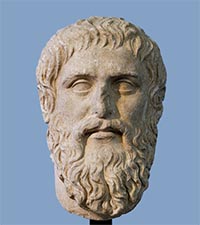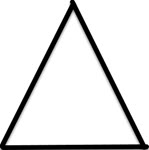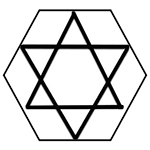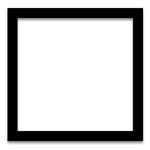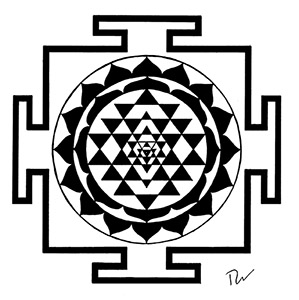
Sacred Geometry
How to Make Powerful Energy Circuits through Shapes & Symbols
Every aspect of sacred geometry is purposeful and meaningful. Sacred geometry symbols including circles, triangles, squares and other forms that carry specific energies. The sum total of the forms used to create larger works of art produce a circuit of energy. The Sri Yantra, for example, is a depiction of the soul’s journey from an outer focus to the subtle energies of the inner world. The symbols of sacred geometry are also connected to the five elements and patterns in nature.
Table of Contents
Share this page with a friend!
Origin of Sacred Geometry
From the simplest atoms to the largest galaxies, geometry determines the structure and function of the universe. This was known to many ancient civilizations, although it is perhaps most evident in the philosophy of the Greeks. To these ancient philosophers, the study of geometry was the study of the fundamental principles that governed the creation of the universe.
Plato and Sacred Geometry
Over the entrance to Plato’s Academy, the following phrase was posted: “Let no one unversed in geometry enter here.” The study of mathematics and geometry were seen as foundational practices, through which a student could train their mind to the point that they could grasp the highest principles of metaphysics.
Mysteries of the Universe
The human mind was seen as capable of penetrating into the mysteries of universe. In studying geometry, the student was not learning something new, but rather penetrating into his or her own intuitive understanding of the order of the universe. The structures of geometry follow from basic axioms. Likewise, all of metaphysics follows from fundamental principles of existence. Thus, the origin of sacred geometry is intertwined with the origin of both philosophy and religion.
Sacred Geometry & Mysticism
Early in the first millennium, there was an explosion of interest in metaphysics. Christian, Gnostic, Islamic and pagan theologians all worked to uncover the order of the universe. While different philosophers disagreed on many details, the model of the universe that was presented by Plato was viewed as a mutual starting point.
Religion and Mystical Philosophies
Theologians of various faiths set forth their own metaphysical systems, attempting to reconcile their own faiths with mystical philosophy. For all of these thinkers, the material world was seen as the result of the unfolding of the Divine Intellect. On the most fundamental level, the universe emanates from the One, which is itself beyond all concepts of being and non-being. It is complete, perfect, and eternal. From this one is born the concepts of duality and balance.
Patterns in Sacred Geometry
From the one source described in nearly all metaphysical systems, the dyad or balance of two equal and opposite forces emerges. There is an inseparable unity of these active and passive forces. The one is divided into subject and object. The root of the universe is formed. This balance is depicted in the well-known yin yang symbol.
Repeated Patterns in Nature
Based on this duality, the universe in its infinite forms takes shape. This occurs according to geometric principles of symmetry and harmony. This can be seen clearly in the natural world. Various sequences of numbers and ratios, such as the Golden Ratio or the Fibonacci sequence, can be seen all over the natural world.
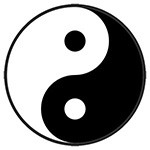
Harmony and Symmetry
These patterns are evident in the way in which shells spiral to the growth patterns of trees. As we learn more and more about the structure of the universe, we continue to find additional examples of harmony and symmetry. In fact, when modern physicists try to decide among competing theories, the one that is most harmonious and symmetrical is chosen. This is because over time it has been proven again and again that our universe is a masterpiece of geometric symmetry and order.
Geometry as an Organizing Principle
From the most fundamental particles to the largest super-clusters of galaxies, the place of geometry and symmetry as essential to the creative principle of the universe. Sacred geometry appears to be an organizing principle in both the physical and spiritual realms.
 Circle Meaning in Sacred Geometry
Circle Meaning in Sacred Geometry
The circle is a physical manifestation that is a counterpart to the spiritual realms. A circle is a primordial form that cannot be further reduced. A circle at the smallest size becomes a point or the bindu. The circle symbolizes infinite space (the element akasha) and expansiveness. The circle also represents the cycles of nature at all levels from the atom to astronomy. The central quest of spirituality is to experience the Oneness of these realms.
Hinduism and the Cosmic Spider
The Hindu vision of the universe is a set of concentric circles. A metaphorical spider sits in the center, both spinning and reabsorbing the threads of reality. The circle represents the One force that both creates and unifies all things. The circle contains the notion that there is no end and no beginning to time. The numeric equivalent of the circle is zero.
Videos Related to Sacred Geometry
Watch nearly 400 videos on the Vocal Medicine Channel!
Triangle Meaning in Sacred Geometry
The triangle is the primary form that can enclose space within straight lines. A third line needs to be added since two lines either intersect or exist as parallels. Thus the triangle is the first form to emerge from chaos and create order or structure.
Downward and Upward Triangles
The downward triangle is a symbol of the divine feminine, often associated specifically with the goddess Kali or Parvati. The downward triangle is a depiction of the water element. An upward triangle represents the masculine energy and the element of fire. The upward triangle is specifically associated with Shiva.
Triangle Meaning in Yantras
Numerous triangles can be interlocked in the center of a yantra. Each of these triangle represents different planes of existence. The root chakra symbol includes a downward triangle indicating the descent of spirit into matter.
Triangles in the Sri Yantra
The meaning of a triangle can also depend on combinations with other symbols. In the Sri Yantra, each of the nine triangles symbolizes circuits in the subtle energy body. Learn more about Yantra Meaning.
Watch nearly 400 videos on the Vocal Medicine Channel!
Hexagon Symbol in Sacred Geometry
The hexagon or hexagram symbolizes the union of male and female forces in intertwined triangles. This is the fusion of polarities that remains in perfect balance. The numerical equivalent of this symbol is a six. The hexagon is related to the air element.
Meaning of a Star Pentagram
A star-pentagram can also be created. This, of course, is associated with the number five. This form is connected to Shiva in his five major aspects: the conqueror of death, the embodiment of knowledge, the source or being of life, the master of lust and sexuality and the lord of the elements.
Interlocking Triangles in the Sri Yantra
In the Sri Yantra (also Shree Yantra or Shri Yantra), the most well-known of all Hindu yantras, there are nine triangles creating a total of forty-three interlocking triangles.
Square Meaning in Sacred Geometry
The square represents the four cardinal directions in sacred geometry symbols. A square symbolizes the foundation or base of the material world. Most yantras have a square as their fundamental form. The numerical equivalent, of course, is four.
Four Gates of the Sri Yantra
On each side of the yantra are gates that open up to invite the viewer into the center of the yantra. The square connects to the earth element in the Vedic tradition (earth, water, fire, space, air). These portals also represent a passage between the heaven world and the plane of material existence. They also symbolize the opening between the inner and outer realms of the individual. The gates protect the center from disintegrating or negative forces.
More Resources for Yantra Meaning
Yantra meaning is a vast topic that is gaining more attention in the arenas of symbolism, meditation and personal growth. The intersection between visual forms and sounds is also an expanding area of research and study. Explore the Gayatri Yantra. Learn more about the Hanuman Yantra.
YANTRA MEANING ARTICLE SUMMARY
This article on yantra meaning includes the meaning of the basic geometric forms in yantras: circles, squares, lotus petals, triangles, hexagrams and more. Specific yantras including the well-known Sri Yantra are discussed as well as the use of yantra forms in building temples.
Author Kathleen Karlsen
Kathleen Karlsen is a musician, artist, writer and speaker. She is the author of two books (Flower Symbols and Vocal Medicine) and over 200 articles. Kathleen, her husband Andrew, and their five children live in Bozeman, Montana. More about Kathleen Karlsen.

